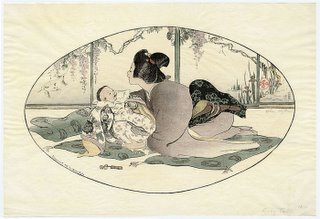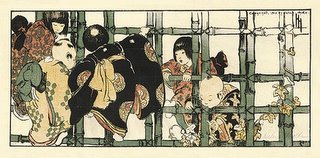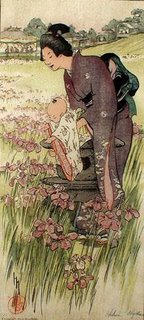Tuesday, November 15, 2005
SO SOON!
Mai Chang
Sunday, November 13, 2005
Helen Hyde
Mai Chang Vue
Art 418: Advanced Printmaking –Elgin
November 12th, 2005
Paper #1
 Helen Hyde
Helen HydeHelen Hyde is internationally one of the best known and outstanding printmakers of the early twentieth century. She exhausted most of her artistic career producing woodblock prints using Japanese methods, and was probably one of the first American artists to use this technique.[1] She was one of the first Western artists and American female artists to study Japanese Printmaking in Japan, which influenced many other artists to go study there.[2]
Hyde was born in Lima, New York in 1868.[3] Two years after she was born, her family moved to San Francisco, California where she began to study art. At the age of twelve she studied under Ferdinand Richardt, a realist painter from Denmark who moved to San Francisco to further his career.[4] In 1882, when she was fourteen, her father died and she and her mother and sisters moved in with her wealthy Aunt, Augusta Bixler,[5] who supported and encouraged her artistic education.[6] After graduating from Wellesley School for Girls, she went to the California School of Design in 1866. Between 1888 and 1894 [7] she studied in New York City with Kenyon Cox, in Berlin with Franz Skarbina, and in Paris with Feliz Ragamey. Ragamey, a French painter and teacher, influenced her significantly and pushed her to go towards “Asian” art. While in Paris, she was inspired by the works of American Impressionist Mary Cassat who paints women and children. Cassat’s influence is evident in Hyde’s work because much or her subjects in her prints are of children, specifically Japanese and Asian children which are because of her Japanese influences.[8] Also, in Paris, she was educated by instructors from the École des Beaux-Arts. However, since she was a woman and a foreigner, she was never acknowledged as an official student of the academy.[9]
In 1894 Hyde returned to San Francisco where she sketched women and children in Chinatown and eventually joined the Sketch Club, which was a professional women artists association. Josephine Hyde, whom she met through the Sketch Club, encouraged her to etch and together they played around with color etchings.[10] In 1895 she bought her own printing press[11] which allowed her to experiment some more with etching and printing. She continued working in Chinatown showing her etchings through William Macbeth and producing illustrations for a volume of children’s verse, Moon Babies, until 1899 when her mother died.[12] After her mother’s death she went to Japan to study brush painting and etching.[13]
Hyde’s concentration in color woodblock printing was a result of her stay in Japan where she learned how to prepare blocks and print them on paper.[14] By 1900 she was producing her own etchings and woodcuts in Tokyo where she met Ernest Fenollosa and Emil Orlik.[15] Orlik, the first European to have traveled to Japan to become skilled in the printing technique, supplied her with her with her first tools and taught her how to cut blocks.[16] When she was able to master the technique she developed her own studio and hired artisans to work for her. [17] Kano Tomonobu was a Japanese printmaker with which she studied closely.[18]
Hyde traveled to a large extent to promote her work and. In 1901 she returned to the states to meet with many dealers in New York and Boston and then she returned to Japan, which became her adopted country, in 1902. She traveled extensively from her main studio in Tokyo from 1903 to 1913 to China, India, and Mexico. Some of her works depict the women and children from the places she visited, but still remained true to her Japanese in style and subject matter. In 1914 she permanently returned to the United States after fifteen years residing in Japan. She won a Bronze Medal in 1915 when she exhibited her prints at the Panama-Pacific International Exhibition. She had a solo show in 1916 at the Chicago Art Institute when she moved to Chicago. Helen Hyde died of cancer at the age of fifty-one in 1919 in Pasadena, California where her sister Mabel Hyde lived.[19] Her family and friends took great care in preserving her prints, documents, letters, and printmaking tools during the next decade in which many saw her work as “sentimental and lacking in boldness.” Today her prints are under careful examination as part of the new interest in the history of American printmaking, female art worlds, and the influence of Asian art and customs to the Americans. [20]
Examining Hyde’s work, it is evidently a world “inhabited by women and children…a world without men. Her infants are under the control of women. They are washed, patted, [and] carried about…provided…physical and emotional needs.”[21] In her works of just children, they are either portrayed individually or playing with other children. She does an astounding job depicting captivating descriptions of children; she is able to obtain the shapes and size of Japanese children as they play and frolic about.[22]
In Hyde’s other prints, “women are shown at work, without children …the space is women’s space. The very absence of men grants these women greater visual space…[and] the viewer must concentrate on the women’s world, whether domestic of public.[23] While the Japanese women are retiring, even [though they appear] shy, they are not there for the male to gaze.”[24] Hyde best puts it in one of her conversations: “[though] we may like men we don’t need them and … there is nothing we can’t do for ourselves except bring children into the world…women…pretend they are they are helpless even if they are not, to give men something to do, to make them feel worth something.”[25]
A remarkably devious palette of colors that include beautiful mauves, soft greens, and delicate yellows[26] helps emphasize the women and children she creates prints of. Her fine treatment of colors are similar to earlier Japanese masters and her use of “white light,” and profoundly rich green and rose are carefully manipulated. Many people like the flat, decorative effect she was able to achieve by not having shadows. In her work titled Baby Talk, a mother and child are depicted completely occupied with one another. Shown in the back is a painted screen of vines and flowers mimicking the natural world. The colors used are faint grays, browns, violets, and yellows.[27] Below are examples of Hyde’s work for you to take a look at and examine her vigilant printmaking skills.
A Taste of Helen Hyde’s Work:
 Baby Talk, 1908
Baby Talk, 1908Color woodcut on paper
11 3/8 x 18 1/2" (image); 14 3/8 x 21 1/4"(paper)
A Day in June, 1910
Color woodcut on paper
14 1/2 x 6 1/2" (image), 18 1/2 x 10 1/4" (paper)
Moon Bridge at Kameido, 1914
Color woodcut on paper
13 3/8 x 9" (image), 16 x 10 1/4" (paper)
Hide and Seek, 1987
Color etching on paper
5 7/8 x 7 1/4

The Bamboo Fence, 1904
Color woodcut on paper
5 1/8 x 11 1/4
* All images taken from: Smithsonian American Art Museum, http://www.americanart.si.edu/
References:
[1] Mason, Tim, and Lynn Mason. Helen Hyde. Washington, D.C.: Smithsonian Institution, 1991. pg 11.
[2] Castle Fine Arts: Biography Pages: Helen Hyde http://www.castlefinearts.com/fs_biography.aspx?page=/Japanese_fine_arts_woodblock_prints/Helen_Hyde_Biography.aspx, pg 1, paragraph 2 retrieved: Nov. 8th, 2005.
[3] Castle Fine Arts. Biography Pages: Helen Hyde, http://www.castlefinearts.com/fs_biography.aspx?page=/Japanese_fine_arts_woodblock_prints/Helen_Hyde_Biography.aspx, pg 1, paragraph 1, retrieved: Nov. 8th, 2005.
[4] Ferdinand Richardt, http://www.northpointgallery.com/browse/fr/, retrieved: Nov. 8th, 2005.
[5] Castle Fine Arts. Biography Pages: Helen Hyde, http://www.castlefinearts.com/fs_biography.aspx?page=/Japanese_fine_arts_woodblock_prints/Helen_Hyde_Biography.aspx, pg 1, paragraph 1, retrieved: Nov. 8th, 2005.
[6] Joan Jensen. Women Artists of the American West: Helen Hyde, American Printmaker, http://www.cla.purdue.edu/WAAW/Jensen/Hyde.html, pg 1, paragraph 2, retrieved Nov. 7th, 2005.
[7] Castle Fine Arts. Biography Pages: Helen Hyde, http://www.castlefinearts.com/fs_biography.aspx?page=/Japanese_fine_arts_woodblock_prints/Helen_Hyde_Biography.aspx, pg 1, paragraph 1, retrieved: Nov. 8th, 2005.
[8] Joan Jensen. Women Artists of the American West: Helen Hyde, American Printmaker, http://www.cla.purdue.edu/WAAW/Jensen/Hyde.html, pg 1, paragraph 2, retrieved: Nov. 7th, 2005.
[9] Wisconsin Union Directorate Art Committee, Helen Hyde. http://www.union.wisc.edu/art/collection/artists/hyde.html, retrieved: Nov. 10, 2005.
[10] Joan Jensen. Women Artists of the American West: Helen Hyde, American Printmaker, http://www.cla.purdue.edu/WAAW/Jensen/Hyde.html, pg 1, paragraph 2, retrieved: Nov. 7th, 2005.
[11] Castle Fine Arts. Biography Pages: Helen Hyde, http://www.castlefinearts.com/fs_biography.aspx?page=/Japanese_fine_arts_woodblock_prints/Helen_Hyde_Biography.aspx, pg 1, paragraph 1, retrieved: Nov.8th, 2005.
[12] Helen Hyde Biographical Information. http://www.Wolman-prints.com/pages/artistbiog/all/h/189.html, retrieved: Nov. 11, 2005.
[13] Joan Jensen. Women Artists of the American West: Helen Hyde, American Printmaker, http://www.cla.purdue.edu/WAAW/Jensen/Hyde.html, pg 1, paragraph 3, retrieved Nov. 7th, 2005.
[14] Joan Jensen. Women Artists of the American West: Helen Hyde, American Printmaker, http://www.cla.purdue.edu/WAAW/Jensen/Hyde.html, pg 2, paragraph 3, retrieved Nov. 7th, 2005.
[15] Castle Fine Arts. Biography Pages: Helen Hyde, http://www.castlefinearts.com/fs_biography.aspx?page=/Japanese_fine_arts_woodblock_prints/Helen_Hyde_Biography.aspx, pg 1, paragraph 1, retrieved: Nov. 8th, 2005.
[16] Helen Hyde Biographical Information. http://www.Wolman-prints.com/pages/artistbiog/all/h/189.html, retrieved: Nov. 11, 2005.
[17] Joan Jensen. Women Artists of the American West: Helen Hyde, American Printmaker, http://www.cla.purdue.edu/WAAW/Jensen/Hyde.html, pg 2, paragraph 3, retrieved Nov. 7th, 2005.
[18] Wisconsin Union Directorate Art Committee, Helen Hyde. http://www.union.wisc.edu/art/collection/artists/hyde.html, retrieved: Nov. 10, 2005.
[19] Castle Fine Arts. Biography Pages: Helen Hyde, http://www.castlefinearts.com/fs_biography.aspx?page=/Japanese_fine_arts_woodblock_prints/Helen_Hyde_Biography.aspx, pg 1, paragraph 1, retrieved: Nov. 8th, 2005.
[20] Joan Jensen. Women Artists of the American West: Helen Hyde, American Printmaker, http://www.cla.purdue.edu/WAAW/Jensen/Hyde.html, pg 5, paragraph 2 & 3, retrieved Nov. 7th, 2005.
[21] Joan Jensen. Women Artists of the American West: Helen Hyde, American Printmaker, http://www.cla.purdue.edu/WAAW/Jensen/Hyde.html, pg 4, paragraph 1, retrieved Nov. 7th, 2005.
[22] Helen Hyde. http://www.davidsonggalleries.com/artists/hyde/hyde.html, retrieved: Nov. 8th, 2005.
[23] Joan Jensen. Women Artists of the American West: Helen Hyde, American Printmaker, http://www.cla.purdue.edu/WAAW/Jensen/Hyde.html, pg 4, paragraph 1, retrieved Nov.7th, 2005.
[24] Joan Jensen. Women Artists of the American West: Helen Hyde, American Printmaker, http://www.cla.purdue.edu/WAAW/Jensen/Hyde.html, pg 4, paragraph 2, retrieved Nov.7th, 2005.
[25] Joan Jensen. Women Artists of the American West: Helen Hyde, American Printmaker, http://www.cla.purdue.edu/WAAW/Jensen/Hyde.html, pg 4, paragraph 2, retrieved Nov.7th, 2005.
[26] Helen Hyde. http://www.davidsonggalleries.com/artists/hyde/hyde.html, retrieved: Nov. 8th, 2005.
[27] Joan Jensen. Women Artists of the American West: Helen Hyde, American Printmaker, http://www.cla.purdue.edu/WAAW/Jensen/Hyde.html, pg 3, paragraph 2, retrieved Nov.7th, 2005.
Wednesday, November 09, 2005
?
Oh...my paper is moving on really slowly. I think I should just stick to one artist.
Mai Chang
Tuesday, November 08, 2005
Alice Fong Yu

Wow! Alice Fong Yu was the first Chinese-American public school teacher. She taught 44 years at the Sanfrancisco Commodore Stockton Elementary School which is now named after her for her wonderful service. Reading about her and knowing more about her gives me inspiration to continue on my path to become an Art teacher.
Mai Chang
Monday, November 07, 2005
Mai Chang
Tuesday, November 01, 2005
Checking blog out
-MC


